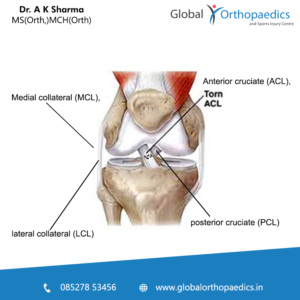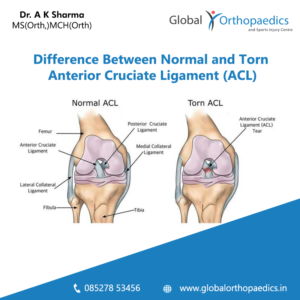Overview:
ACL (Anterior Cruciate Ligament) is the worst thing that can happen to anyone. ACL is a major ligament in the knee, and if it’s ripped knee would give out.
Anterior cruciate (ACL), medial collateral (MCL), lateral collateral (LCL), and posterior cruciate (PCL) are the four longest ligaments in the human body that hold the knee joints together.
We all rely on our knee for day to day activities. A knee ligament injury can be painful and debilitating and would stop anyone by doing their daily activities.
A person should contact a doctor immediately in case of knee ligament injury.
ACL injury:
ACL tissues connect thighbone to the shinbone, most ACL injury occurs while playing several sports like basketball football tennis, and skiing. When a knee gets sharply twisted or goes stretched beyond its normal range of motion, it causes ACL injury and leads to unstable pain and swelling.
A partially torn ACL can be restored, in the normal state through progressive physical therapy and rehabilitation. However, there is no critical cutoff, when should contact the doctor if ACL is torn.
If anyone feels a knee uncertainty, they should meet with the surgeon.

Diagnosis:
A doctor will check knee tenderness, swelling, pain, and will perform several tests by moving the affected knee. Physical examination helps to know the integrity of the ACL. They also compare the mobility on the unaffected knee, to confirm the ACL rupture in the affected knee.
In the next step, surgeons perform an X-ray or MRI, which gives detail about ligament position. A torn ligament or soft tissues get visible in this process. After checking the criticality doctor will perform the best suitable treatment.
Treatment:
The first thing should be done in the knee torn is to take rest, keep weight off it for some time, apply ice, and wrap the affected area. A doctor may use syringe drain fluid to reduce the swelling.
Types of ACL treatment are mentioned below:
Non-surgical treatment:
Non-Surgical treatment is successful for those who do not have any mobility issues in the knee or have a partial tore. Non-surgical treatment with rehabilitation and bracing is an option for only one third ACL injuries, often for older and less active persons.
Surgical treatment:
This is a commonly suggested treatment for them who are suffering from combined injuries. A repaired ACL may fall after time. Therefore, doctors suggest replacing the injured ligament with a substitute graft from another part of the body or external source.
Conclusion:
Studies on how to prevent ACL injuries are still going on. A successful ACL treatment restores the stability and function of your knee. ACL recovery generally takes 9 months, which can differ according to patient age, activity routine, and health conditions.



